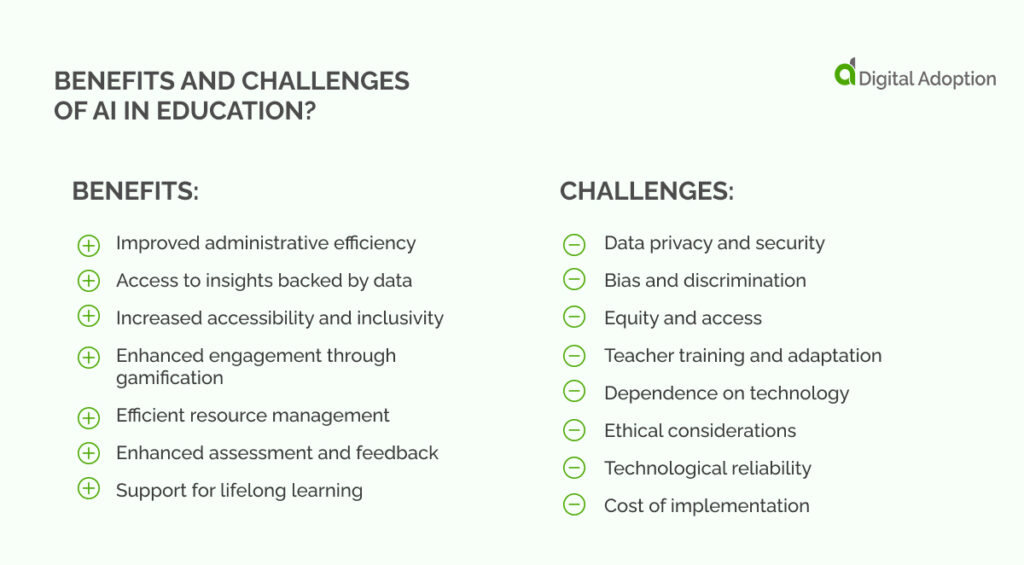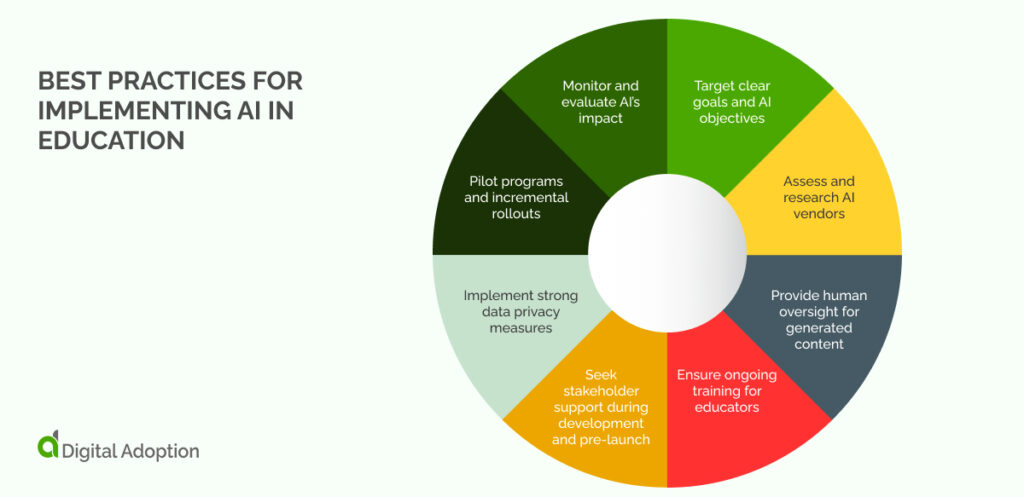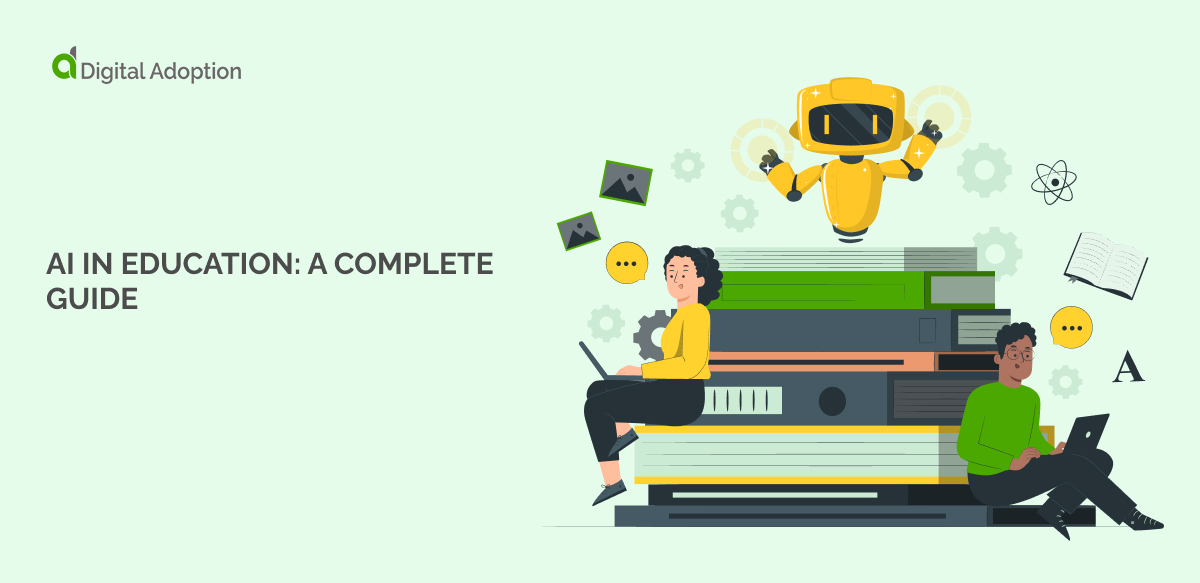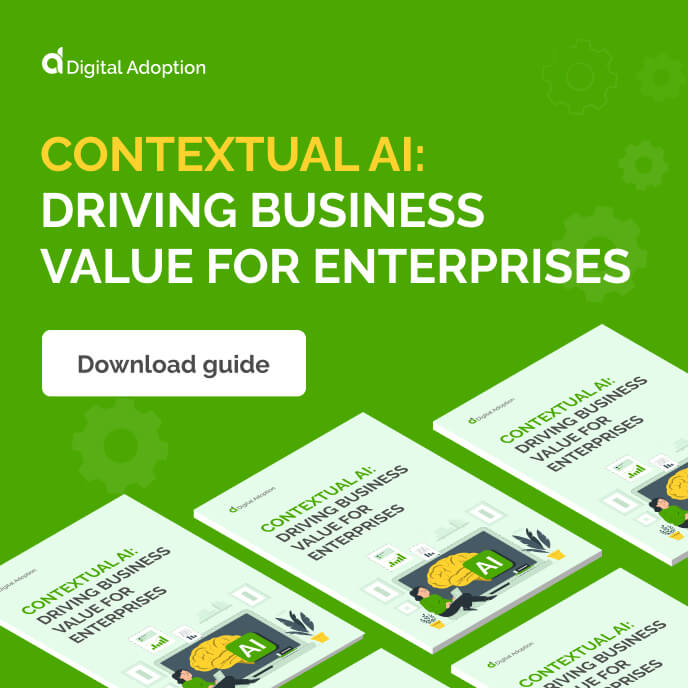Education has long served as the foundation for knowledge-building and societal success.
Take the rise of globalized industries such as banking, healthcare, and technology. Each pioneered by centuries-old educational institutions committed to facilitating training and development.
Today’s technological advances are returning the favor, helping improve the institutions that once enabled it. Bleeding-edge AI solutions are entering the market at a rapid pace, and their impacts can be felt sector-wide.
Modern teaching and learning capabilities are delivered are being reimagined through AI. Senior educators, academics, and budding students can now access AI-powered tools and resources to expedite learning.
This article explores AI in education, examining its implementation for improved learning experiences. We’ll discuss top application areas, benefits, challenges, and best practices for responsible AI use. Finally, we’ll consider AI’s prospective role in future educational environments.
What is AI in education?
AI in education involves leveraging AI-enabled technologies to enhance key educational processes, such as teaching strategies, curriculum building, student digital literacy, and more.
Educational professionals are using various AI solutions that are capable of performing intelligent actions to accelerate learning. These AI models typically leverage advanced algorithms to tackle complex tasks, similar to how the human brain learns and adapts.
Tools underpinned with machine learning (ML) enable accurate pattern detection for test scoring and predicting future student performance. These forecasting capabilities can help teachers anticipate future learning needs and highlight factors leading to potential underperformance.
Deep learning (DL) can be applied to unsupervised tasks, such as exploring new teaching methods or identifying hidden patterns in student engagement data. Student engagement data wouldn’t be categorized as “good” or “bad” engagement but might include factors like time spent on materials, click-through rates, or participation levels.
Implementing AI into education must be done responsibly. Toward the end of the article, we’ll provide some best practices educators can follow to ensure safe and responsible AI.
What are some examples of AI in education?
We’ve explored some ways AI is impacting education. Let’s now look at some specific application areas that will be most affected.
Personalized learning experiences
AI helps students realize and tap into their potential through personalized learning. AI can analyze student data to craft customized lesson plans tailored to individual preferences.
Personalized learning experiences can be further enhanced through AI. These include intelligent tutoring apps and virtual chatbots for addressing student queries 24/7
Example: AI-driven educational platform could adjust the difficulty of assignments in real-time, ensuring that each student remains challenged yet not overwhelmed. This creates a deeper understanding of the material and supports better learning experiences.
Empowering educators with data
With the data at hand, educators can identify pain points and deploy targeted improvements. This analytical access also gives educators improved assessment capabilities. Manual test scoring, faculty KPIs, and student performance can be efficiently monitored.
Example: An AI system could provide insights into the most effective teaching methods, enabling educators to refine their strategies. Furthermore, it can pinpoint areas where students struggle the most, allowing for targeted interventions and support.
Improving student digital literacy skills
Goldman Sachs research reveals workflow shifts could expose 300 million full-time jobs to AI automation. Today’s students will make up tomorrow’s workforce. Leveraging AI to build future-ready skills and improve digital literacy is key.
Example: An AI-based learning tool could simulate real-world tech scenarios, offering hands-on experience in programming, data analysis, and other critical digital skills. This ensures students are well-prepared for an AI-integrated job market.
Augmenting and automating teaching
AI can support lesson planning by suggesting resources and activities that align with curriculum standards and student needs. AI automation can take over mundane administrative tasks, allowing teachers to refocus on more meaningful ones.
Example: An AI system could automate attendance tracking, assignment grading, and schedule management. This allows teachers to concentrate on providing personalized feedback, mentoring students, and developing innovative curriculum content.

What are the benefits of AI in education?
Out of 500 teachers from the U.S. surveyed by Forbes Advisor, more than half “said they believe AI has had a positive effect on the teaching and learning process. Less than 1 in 5 cited a negative effect.”
AI’s reach in education isn’t slowing, whether through automated systems, deploying AI chatbots, or gamified learning.
Let’s take a closer look at how AI benefits education sectors.
Improved administrative efficiency
Educators can focus on teaching and delivering better student care while AI handles administrative tasks. AI can reduce the burden of manual scheduling, attendance tracking, and grading. Various available AI tools reduce errors and increase efficiency. These ensure administrative processes run smoothly and accurately.
Access to insights backed by data
AI provides educators with valuable insights backed by data. Teachers can employ AI tools to understand student performance and highlight recommended actions. These insights can guide curriculum adjustments and teaching strategies for achieving ideal learning outcomes. For instance, AI analytics can highlight patterns in student behavior and performance. This lets educators make proactive interventions and support struggling students.
Increased accessibility and inclusivity
AI can enhance accessibility for students with disabilities by providing customized learning tools and resources. For example, AI-powered speech-to-text apps can help students who are hard of hearing. Text-to-speech tools, on the other hand, can assist those with visual impairments. These technologies ensure all students have equal access to educational content, fostering an inclusive learning environment.
Enhanced engagement through gamification
AI-driven gamified learning platforms can increase student engagement by making learning more interactive and enjoyable. These platforms use game design elements to motivate students and make educational content more appealing. Through gamification, AI can transform standard learning into a more engaging experience. This includes exploring AI-powered learning modules with challenges, rewards, and interactive in-app elements.
Efficient resource management
AI helps educational institutions manage resources more effectively. By analyzing data on resource usage, AI can optimize the allocation of materials, staff, and facilities. This ensures that resources are used efficiently, reducing waste and lowering operational costs. For example, AI can predict peak times for library usage, allowing for better staffing and resource availability.
Enhanced assessment and feedback
AI provides a more precise and timely assessment of student work. Automated grading systems offer immediate feedback, allowing students to understand their mistakes and quickly learn from them. This cycle of efficiency supports a deeper learning process and helps students improve their performance over time.
Support for lifelong learning
AI facilitates lifelong learning by providing flexible and accessible learning opportunities for individuals of all ages. Online AI-powered learning platforms offer courses and training programs that can be accessed anytime, anywhere. This flexibility supports continuous education and skill development, which is crucial in shifting job markets.
What are the challenges of AI in education?
AI poses very material risks and concerns in education and beyond.
For example, large language models (LLMs) supporting generative AI like ChatGPT have shown a high likelihood of generating false or misleading outputs.
This may prove concerning, as a study published in the Journal of Humanities and Social Sciences reveals that 63.4% of students surveyed have used AI-based tools for their studies.
If not implemented responsibly, educational processes can become plagued with skewed falsities. Let’s examine some current and future challenges of implementing AI in education.
Data privacy and security
Data is the fuel that underpins modern AI, which naturally raises concerns about its privacy and security. Cybercriminals and threat actors’ methods are becoming more sophisticated. Unauthorized access or data breaches can lead to the misuse of sensitive student information. Ensuring robust data protection protocols is crucial to maintaining trust and compliance with regulations.
Bias and discrimination
AI algorithms can perpetuate and even compound existing biases present in the data they are trained on. This can result in unfair treatment of certain student groups and programs, causing hallucinations and deeply affecting student opportunities and learning processes. For instance, biased algorithms might disproportionately identify students from specific backgrounds needing remedial support. This can lead to stigmatization and unequal educational experiences.
Equity and access
The implementation of AI in education may widen the digital divide. Not all schools have the resources to integrate advanced AI technologies. Students in underfunded schools may lack access to AI-driven educational tools. This can deepen existing inequalities. Equitable access to AI resources is essential for promoting an inclusive academic environment.
Teacher training and adaptation
Educators need adequate training to incorporate AI tools into their teaching practices. The rapid pace of AI development can make it challenging for teachers to stay updated with the latest technologies. Without proper training, the potential benefits of AI in education may not be fully realized, and teachers might struggle to integrate these tools into their curricula.
Dependence on technology
An overreliance on AI could undermine traditional teaching methods and reduce human interaction in the classroom. While AI can enhance learning, it is not a substitute for the critical thinking and emotional support human teachers provide. Balancing AI integration with traditional teaching methods is crucial for maintaining a holistic educational approach.
Ethical considerations
The use of AI in education raises ethical questions regarding the extent of its influence on student learning and decision-making. There is a risk that AI could be used to monitor and control student behavior excessively. Establishing clear ethical guidelines and policies is necessary to ensure AI is used responsibly and benefits all stakeholders.
Technological reliability
AI systems are not infallible and can experience technical issues that disrupt learning processes. Dependence on technology means that any malfunction or downtime can significantly impact educational activities. Ensuring the reliability and robustness of AI systems is essential to prevent disruptions and maintain continuity in education.
Cost of implementation
Integrating AI into educational institutions can be expensive. The initial investment in AI technology, infrastructure, and training can strain budgets, particularly for smaller or underfunded schools. Assessing the cost-benefit ratio and securing adequate funding is crucial for sustainable AI integration.
Best practices for implementing AI in education

Sustainable AI in education means understanding how to maximize the benefits, all while mitigating risks and challenges.
To strike this balance, let’s look at some of the best practices educational leaders can employ when adopting AI.
Target clear goals and AI objectives
Begin by defining clear goals and objectives for AI integration. Determine what you aim to achieve. Is the goal to enhance personalized learning? Improve administrative efficiency? Or increase student engagement? Set forth specific targets that help align AI initiatives with institutional priorities.
Assess and research AI vendors
Thoroughly assess and research potential AI vendors. Evaluate their track record, technology capabilities, and alignment with your educational goals. Look for vendors with proven success in the education sector and strong data privacy practices. Comparing multiple options allows you to select a vendor that best meets your needs and balances the budget.
Provide human oversight for generated content
AI-generated content requires human oversight to ensure accuracy and relevance. Teachers and administrators should review AI outputs regularly to verify the quality and appropriateness of educational materials. This oversight helps maintain academic standards and prevent the dissemination of misleading or incorrect information.
Ensure ongoing training for educators
Continuous training is essential for educators when using AI tools. Provide professional development programs that cover the latest AI technologies and their applications in education. Ongoing training helps educators stay updated and proficient in using AI to enhance teaching and learning experiences.
Seek stakeholder support during development and pre-launch
Involve stakeholders in the development and pre-launch phases, including teachers, students, and parents. Gathering input from these groups ensures that AI efforts address real needs and concerns. Stakeholder support ensures all are on board, as users feel their perspectives have been considered.
Implement strong data privacy measures
Data privacy and security should be at the forefront of all AI initiatives. Leverage readily available policies for informing data collection, storage, and usage. Staying in compliance with regulations such as GDPR and FERPA is key when it comes to data. Strict parameters for protecting student and faculty information help build trust and mitigate potential risks.
Pilot programs and incremental rollouts
Start with pilot programs to test AI tools on a small scale. Evaluate their effectiveness and collect feedback from participants. Well-timed rollouts allow for adjustments based on real-world experiences. This reduces the risk of disparate projects and large-scale implementation issues.
Monitor and evaluate AI’s impact
Routinely monitor and assess the impact AI is having post-implementation. Use metrics and analytics to evaluate performance against your initial goals. Ongoing evaluation helps identify areas for improvement and ensures that AI initiatives deliver sustainable results.
What does the future of AI in education look like?
When done right, AI promises to accelerate learning capabilities for educators worldwide.
But what does AI’s prospective role within education look like? Education spurred on through AI must be guided responsibly and incrementally.
Leading educators must preemptively prepare for the onset of AI in all learning verticals. They should work closely with EdTech providers to establish standardized parameters when deploying AI solutions.
A GOV.UK survey found that most institutions are not actively responding to GenAI. Nearly two-thirds of primary and secondary school leaders said their schools had no plans to address this issue or make changes.
When thoughtfully implemented, AI can revolutionize education. However, this transformation requires a proactive and collaborative approach.
Educators must work with EdTech providers, establish standards, and follow guidelines like those from the World Economic Forum. This involves designing for equity, enhancing human-led teaching, co-designing with stakeholders, and ensuring economic viability and access.













